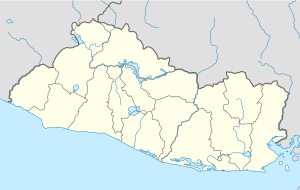Soyapango
| Soyapango | ||
|---|---|---|
|
Coordinates: 13 ° 40 ′ N , 89 ° 6 ′ W Soyapango on the map of El Salvador
|
||
| Basic data | ||
| Country | El Salvador | |
| Department | San Salvador | |
| City foundation | November 20, 1542 | |
| Residents | 290.412 (Ber. 2006) | |
| Detailed data | ||
| surface | 290 km 2 | |
| Population density | 7,064 inhabitants / km 2 | |
| height | 648 m | |
| City structure | 6 distritos | |
| Waters | Río Las Cañas | |
| Time zone | UTC −6 | |
| City Presidency | Carlos Alberto García Ruíz FMLN | |
| Soyapango | ||
The city of Soyapango is a municipality in El Salvador , it is located in the department and in the Área Metropolitana of San Salvador .
geography
Soyapango is located 7 kilometers east of the city center of San Salvador, bounded on the north by the municipalities: Ciudad Delgado and Tonacatepeque, on the south it borders on Santo Tomas and San Marcos, on the east it borders on the municipality of Ilopango and on the west on Ciudad Delgado and San Salvador.
Topographic elevations are the Cerro San Jacinto and the Cerro El Mirador. The topography of Soyapango is more turbulent in the south than in the north.
Rivers: Río El Acelhuate, Río El Cañas, Río Tapachula, Río Chantecuán, Río El Sumpa, Río El Sauce y Río El Chagüite. Quebradas: Quebrada El Arenal and Quebrada El Aposento The waterways are often misused to remove solid and liquid toxins, which is why they are highly contaminated by industrial sewage and waste and polluted by domestic sewage.
The climate is similar to that of San Salvador, for which there are studies. It has a warm climate all year round, with December, January and February being the coolest months. Temperatures rarely drop below 20 ° C. From late October to late March is the dry season and it rains very little, it is windy and the climate is a little fresher. From April to September is the rainy season in which especially near a river floods can occur - it is very warm.
history
In Nawat , which was spoken by the Pipiles in the Soyapango area, Soyat or Zuya means a species of palm and Pango means valley or plain.
On November 20, 1542, the Ordenanzas de Barcelona ( leyes nuevas ) were issued in Spain , which comprised 40 articles. With the 11th article, the Real Audiencia de los Confines entre Tierra Firme (Nicaragua and Guatemala) was created. This body represented the royal judiciary and also represented the viceroy in this part of New Spain . It was decided by four oidores , the senior one presiding. On January 15, 1543 Alonso de Maldonado was the managing governor, the other Oidores were Diego de Herrera, Pedro Ramírez de Quiñónez and Juan Rogel.
On January 15, 1543, this Real Audiencia de los Confines was entre Tierra Firme in the Ciudad de Gracias a Dios in Honduras and gave the title of Pueblo (village) to 182 places.
In the documents the place Coyapango was named which is today the center of the Municipios Soyapango.
The first administrative unit of San Antonio Zoyatpango del Llano belonged to the Intendencia de San Salvador , which in turn belonged to the Partido de San Salvador . At that time the area of today's El Salvador was divided into 17 such partidos .
On February 7, 1824, before El Salvador was constitutionally established, the area of Soyapango was assigned to the Alcaldía Mayor de Sonsonate .
On June 12, 1824 Juan Manuel Rodríguez was Supremo Director of the newly created El Salvador. The first constitution of El Salvador divided El Salvador into four administrative units: San Salvador, Sonsonate, San Vicente and San Miguel. On the same occasion, the 24 casrios , which formed Soyapango between 1786 and 1824, were upgraded to villages and Soyapango to a municipality. Fernando Figueroa upgraded Soypangon Villa on May 16, 1907 , which was published in the Diario Oficial on May 21, 1907.
On January 21, 1969, Fidel Sánchez Hernández upgraded the Soyapango to a Ciudad (city).
Educational institutions
In Soyapango there are 34 public and 14 private schools, one of the private schools is the Universidad Don Bosco .
Industry and Commerce
The municipality of Soyapango has the most intense industrial activity in El Salvador. There is a food industry, textile industry, leather industry, matchstick production, pharmaceutical companies, paint production, detergent production, distilleries, poultry slaughterhouses, paper and cardboard factories, charcoal burners. There are large shopping malls like Plaza Soyapango , Unicentro and Plaza Mundo . More than 5000 people work here in informal trades - they do not meet the banks' lending criteria and have to make a living by selling on the street. A relocation of industrial companies to other municipalities is a threat, as jobs go with them and there are already many unemployed in Soyapango.
traffic
More than 1000 collective transport vehicles operate in Soyapango. The buses to the east of El Salvador pass here. The fleet is estimated at 50,000 vehicles including private transport. Taxi companies and collective local public transport, which often overloads the traffic area and also uses the air as a health hazard.
Fiestas
The patron saint of the Church of Nuestra Señora del Rosario is celebrated on the first twelve days of October. This includes processions , an economic and handicraft fair. A parish fair with mechanical toys for adults and children.
Personalities
- Léster Blanco (* 1989), football player

